Effect of the Dispersion Orders on the Widths of the Coexistence Domain and Combs Spectra of Bright and Dark Solitons in Microresonators
Abstract
Using the Lugiato–Lefever model, we base on the hysteresis approach to analyze the coexistence domain of bright and dark solitons in the zero, normal, and anomalous dispersion regimes. Our results also highlight that the fourth-order dispersion term affects the width of the frequency combs of both dark and bright solitons. It also allows the appearance of dispersive waves on the soliton spectra that disappear for high values of the fourth-order dispersion followed by the soliton destabilization into harmonic oscillations and oscillation packages.
1. Introduction
Optical frequency combs are among the discoveries that have most revolutionized the world of very high-precision metrology. They have become almost ubiquitous tools for optical analysis, biomedical imaging, optical communication, quantum information, and more [1–7]. Before the exploration of the optical Kerr effect in whispering-gallery-mode resonators, optical frequency combs were developed from mode-locked lasers. Nowadays, optical frequency combs have also found much border sources such as continuous lasers [8], optical fibers [9], optoelectronic oscillators [10, 11], and more [1, 7, 12]. However, in 2004, two independent teams generated optical frequency combs for the first time through amorphous [13] and crystalline [14] whispering-gallery-mode resonators.
Among the resonator parameters that explain the generation of Kerr frequency combs, chromatic dispersion plays a major role. Indeed, it strongly affects the pumping power required for combs generation, the range of the generated frequency combs, the shape of the power spectrum envelope, and even the repetition rate of the generated pulse in the resonator [15, 16]. The generation of Kerr optical frequency combs was extensively studied considering zero dispersion regime [17, 18] and high-order dispersion regimes that strongly affect the dynamics of Kerr frequency combs [19–21]. For example, dark solitons in the anomalous group velocity dispersion regime are only obtained when considering the fourth-order dispersion term [20, 22–24]. Besides, two branches of dark solitons having different polarization states and power peaks may coexist in normal dispersion optical resonators subject to a coherent optical injection [25]. Furthermore, it was reported that the third-order dispersion term allows the coexistence of dark and bright solitons in the cavity for a pump power taken around a critical value of the pump [23, 26, 27]. It was also shown that one of the modifications brought by higher order dispersion terms is the generation of dispersive waves [15] which can originate from the oscillation of the tails of the Kerr solitons induced by the third-order dispersion (TOD) [28]. It has been shown experimentally that the emission of a dispersive wave widens the spectral bandwidth of the frequency combs to two-thirds of an octave [29].
In this paper, we exploit the hysteresis curves to determine the areas in parameter space where solitons coexist. Besides, the broadening of the frequency combs spectral bandwidth under the effect of the fourth-order dispersion (FOD) term is also studied. It could be important if one can harness the range of the system parameters notably the pump, delimiting the coexistence of solitons. Moreover, the effect of higher order dispersion terms on the frequency combs and dispersive waves could bring a general benefit for telecommunication applications and high-frequency metrology [29].
This paper is structured as follows. In Section 2, we present the Lugiato–Lefever equation (LLE) model; then, in Section 3, we highlight the parameter space region where dark and bright solitons coexist in the case of zero, normal, and anomalous group velocity dispersion regimes taking into account the third-order dispersion (TOD). In Section 4, we characterize the effects of fourth-order dispersion (FOD) on the width of the Kerr combs spectra. The paper ends with a conclusion.
2. The Model
3. Determination of the Coexistence Domain of Stable Localized Structures Taking into Account the TOD
3.1. Coexistence Domain of Stable Localized Structures When the Group Velocity Dispersion Is Zero
It has been shown in [23] that for an appropriate choice of α, bright and dark solitons coexist for pump power values taken in the vicinity of a critical pump power value Fc (equation (3)). To delimit the coexistence domain, in Figure 1, we plot the bifurcation diagrams of the mean energy solutions (equation (4)) as a function of the external pump amplitude F for d2 = 0, d3 = 4.08 × 10−5, and d4 = 0. Figures 1(a) and 1(b) show the bifurcation diagrams for increasing and decreasing F, respectively. The red lines of low energy represent bright solitons, the black lines of high energy characterize dark solitons, and the blue lines are coherent states. As F increases, we observe in the cavity for F = 1.69, the transition from a bright soliton to a dark soliton (Figure 1(a)). For F > 1.725, the blue line represents the high energy stable equilibrium ρh and also highlights a threshold power F = 1.725 beyond which there is no dark soliton in the cavity. Similarly, as F decreases, for F = 1.66, a transition occurs from a dark soliton to a bright soliton (Figure 1(b)). For F < 1.64, the blue line represents the stable low energy equilibrium ρb, which highlights the threshold power F = 1.64 below which bright soliton does not exist in the cavity. Superposing Figures 1(a) and 1(b), a hysteresis zone for F ∈ [1.66,1.69] is observed around a critical value Fc = 1.688 where bright and dark solitons coexist in the cavity (Figure 1(c)). This gives the range of pump powers where bright and dark solitons coexist for zero GVD (d2 = 0). The plots of some bright and dark solitons as well as their frequency combs using parameters of Figure 1 are given in Figure 2(a). In the next subsection, we will also study the coexistence domain of the localized structures in the normal and anomalous GVD regimes and take into account the TOD.
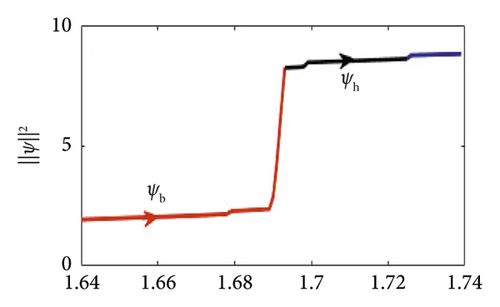
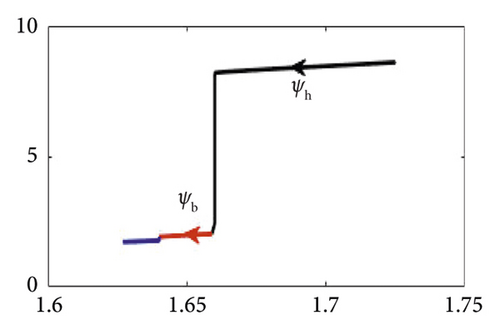
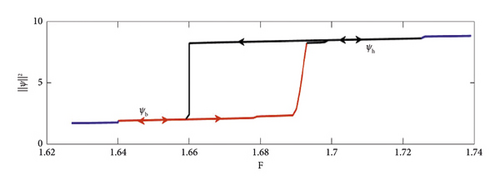
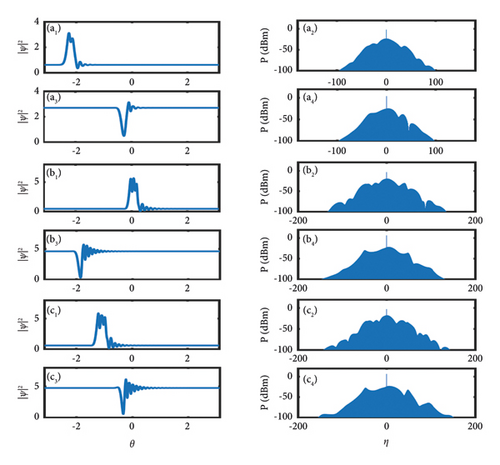
3.2. Coexistence Domain of Stable Localized Structures in the Case of Normal and Anomalous Dispersion Regimes
In the case of normal GVD (d2>0), the bifurcations for increasing and decreasing values of F can be also used to evaluate the values where these structures can coexist as shown in Figures 3(a) and 3(b), respectively. Figure 3(c) is a superposition of the two and witnesses such coexistence. The coexistence of these solitons is illustrated in Figure 2(b) taking F = 2.5. The red lines characterize bright solitons, while the black ones represent dark solitons. The blue lines are low and high energy coherent states that occur for (F<2.27) and (F>2.6), respectively. Indeed, in the normal GVD regime, the threshold pump amplitudes required for the generation of Kerr solitons are higher than those in the zero GVD regime. We highlight a range of values of F ∈ [2.38, 2.52] but not exactly around the critical Fc = 2.72 where bright and dark solitons coexist (Figure 3(c)) versus F ∈ [1.66, 1.69] when d2 = 0 (Figure 1(c)). Moreover, the width of the coexistence domain is larger (0.14) than in the case of zero GVD (0.03). It is also important to note that these solitons are obtained for a detuning α = 4 which is higher than the detuning for which solitons are recorded in the case of zero GVD [23].
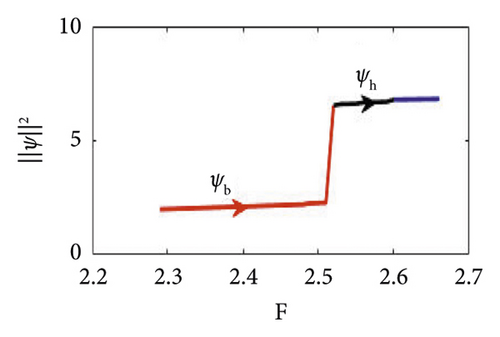
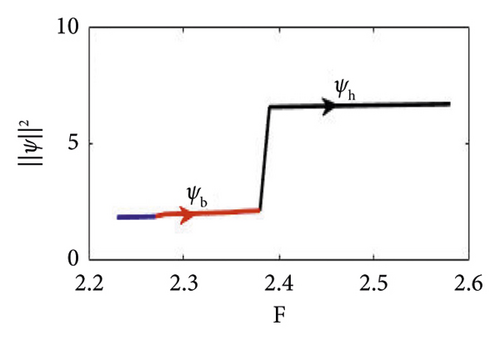
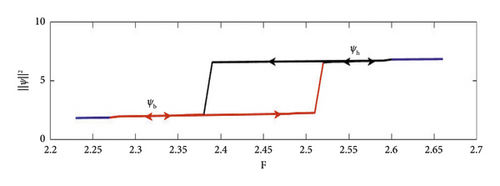
In the case of anomalous GVD (d2<0), the bifurcation diagram of stable stationary solutions as a function of the pump amplitude F is shown in Figure 4. The red, black, and blue lines also characterize the bright and dark solitons and the stable coherent states, respectively. Samples of bright and dark solitons as well as their frequency combs are shown in Figure 2(c) for the same value of F = 2.72. Note that the fourth-order term is inserted to favour the formation of bright solitons [15]. There is also a hysteresis zone occurring in higher range of F (F ∈ [2.66, 2.752] and around the critical pump Fc = 2.72) where bright and dark solitons coexist with a width of the coexistence domain equal to 0.096. This width is reduced compared to 0.14 found in the case of normal GVD.
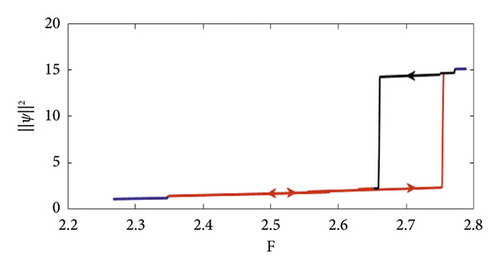
4. Effect of the FOD on the Width of the Kerr Combs Spectrum
In this section, we investigate the effect of the FOD on the width of the Kerr combs spectrum in the case of normal and anomalous GVD. These Kerr comb spectra are the frequency characteristics of Kerr solitons formed by switching waves [23]. Recall that the addition of the FOD affects the bandwidth of Kerr optical frequency combs [15, 29]. Here, we vary the fourth-order dispersion term (d4) and analyze the effect on the combs spectrum in the cases of normal and anomalous GVD regimes.
4.1. Effect of the FOD on the Width of the Kerr Combs Spectrum in the Case of Normal GVD Regime
We present in Figure 5 the bright solitons obtained with the normal GVD and the corresponding frequency combs for different values of d4. Note that the simulations are done for d2 = 2.43 × 10−4, d3 = 6.79 × 10−6, F = 2.46, and α = 4. It can be seen that as the value of d4 increases, the soliton combs lose their symmetry and widen towards low frequencies. For values within d4 ∈ [1.49×10−8, 2.17×10−8], there is a generation of a dispersive wave of low power on the side where the spectrum spreads (see Figures 5(b1), (c1), and (d1)). This is in agreement with the work of Bao et al. [15], where it is shown that one of the modifications brought by the higher order dispersion terms is the generation of a dispersive wave. As d4 is increased, the dispersive wave gains in power as well as it approaches the central mode of the frequency combs (Figures 5(b1), (c1), and (d1)). Conversely, the frequency combs spread out more and more towards the dispersive wave until they merge. For values of d4 ≥ 2.17 × 10−8, the soliton destabilizes and gives harmonic oscillations with distinctive peaks in the spectrum (Figures 5(e) and (e1)).
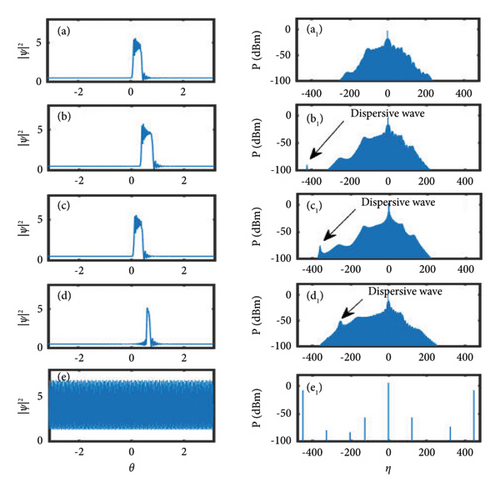
In Figure 6, we present the dark solitons and the corresponding spectra for different values of d4 in the case of normal GVD. As with bright solitons, we observe a broadening of the spectrum with the generation of a dispersive wave for d4 = 1.39 × 10−8 (see Figure 6(b1)) far from the pump mode with low power. But, unlike bright solitons, the increase in the value of d4 directly destabilizes the soliton into an oscillating pattern similar to an amplitude modulation (see Figures 6(c) and (c1)).
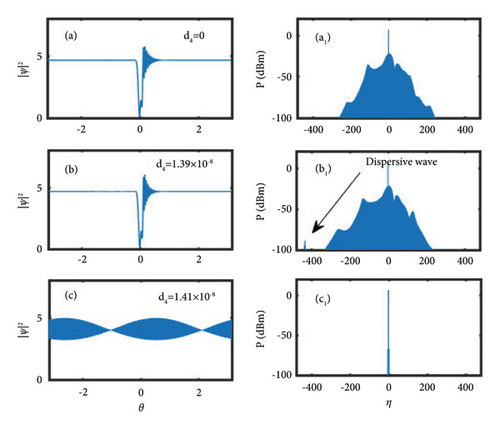
4.2. Effect of the FOD on the Width of the Kerr Combs Spectrum in the Case of Anomalous GVD Regime
For different values of d4 in the case of the anomalous GVD, we illustrate bright solitons and their combs (Figure 7). As in the case of normal GVD, other parameters are fixed as follows: d2 = −3.625 × 10−7, d3 = 6.79 × 10−6, F = 2.48, and α = 4.
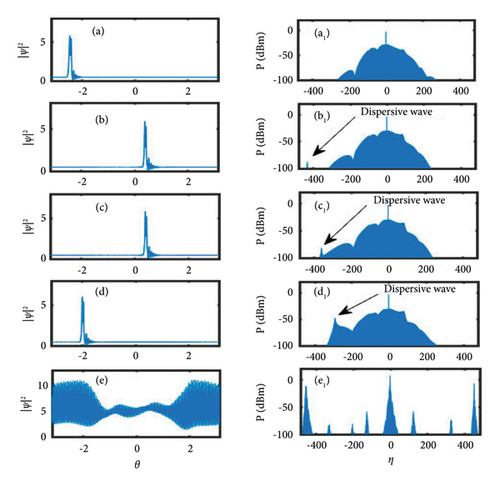
Similarly, increasing the value of d4 also causes the combs spectrum to broaden and progressively become asymmetric. Likewise, the dispersive waves appear in the bright soliton spectrum from the value of d4 = 1.55 × 10−8. We also observe the shift of the dispersive wave towards the central mode and for d4 ≥ 2.58 × 10−8, the soliton destabilizes into oscillation packages characterized by nonuniform packages in the spectrum that are almost symmetric from the central frequency (Figures 7(e) and (e1)). In the case of anomalous GVD, the dispersive wave in the frequency combs of the dark solitons was not observed (not shown) indicating that these solitons are more sensitive to a slight change of the fourth-order dispersion term.
5. Conclusion
In this paper, we have studied the effects of higher order dispersion terms on the coexistence of solitons and optical frequency combs generated by whispering-gallery-mode microresonators. By playing with the values of the chromatic dispersion parameters and their signs, we have shown that they strongly influence the dynamics of Kerr frequency combs (the type of pulse, their stability, the shape of the frequency combs envelope, and the bandwidth of the frequency combs). In the case of zero and anomalous GVD regimes, we have also highlighted that the pump power ranges where bright and dark solitons coexist are found around the critical pump (the critical pump depends only on the detuning α).
Similar to the results obtained by Coen et al. [31], it has been noticed a broadening of the frequency combs spectra accompanied by the generation of dispersive waves. This is caused by the FOD in the case of the normal GVD (for both bright and dark solitons), but only with bright solitons in the case of anomalous GVD. Besides, the dispersive waves have been found abundantly with bright solitons, that is with a larger range of the FOD, while they are selective with dark solitons, that is with a specific value of the FOD. This highlights the possibility of controlling the width of the Kerr frequency combs with the fourth-order dispersion term. Future works will address the influence of thermo-optic effects on the widths of the hysteresis and the frequency combs spectra in microresonators [37].
Conflicts of Interest
The authors declare that they have no conflicts of interest.
Open Research
Data Availability
The data used to support the funding of this study are available from the corresponding authors upon request.




